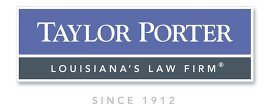Federal Government’s Historic $2 Trillion Coronavirus Stimulus Bill Nears Finish Line
March 25, 2020
Here’s What We Know
Taylor Porter is closely monitoring the $2 trillion stimulus package known as the Coronavirus Aid, Relief, and Economic Security Act (or the ‘‘CARES Act”), which the Senate is expected to approve later today and the House is expected to approve tomorrow. By all accounts, the President stands ready to sign the bill once passed by Congress.
Click here for the latest version of the Bill that Senate Majority Leader Mitch McConnell has released.
Small businesses are eagerly awaiting the anticipated $2 trillion stimulus package that is expected to distribute $349 billion in loans to small businesses under section 7(a) of the Small Business Act, 15 U.S.C. 636(a). In many instances, if the loaned funds are used for delineated purposes, significant portions of the loans will be forgiven. For any small businesses that plan to apply for such a loan, now is the time begin the process of gathering relevant financial and tax records which are likely to be required in the application process.
Below is a summary of loan-related provisions appearing in the latest available version of the bill which are of interest to small businesses. These provisions are found within Title I of the Act, Sections 1101 – 1114, titled “Keeping American Workers Paid and Employed Act.”
Please note this is pending legislation subject to revision. The U.S. Senate will be voting on the bill today, March 25, 2020, and it must then be approved by the U.S. House of Representatives and signed by President Trump. We will review and analyze the final legislation once it has been released to the public.
Small Business Loan Provisions of the Keeping American Workers Paid and Employed Act
- Qualified SBA lenders would be able to loan money directly to eligible customers, who can apply for loans directly through those lenders rather than through the Small Business Administration and its on-site portal.
- Applies to loans made to employers of 500 or fewer employees during the “covered period” beginning on February 15, 2020 and ending on June 30, 2020.
- Individuals who operate under a sole proprietorship or as an independent contractor, and eligible self-employed individuals can receive a covered loan.
- The general formula which applies to most employers for purpose of calculating the maximum amount of the loan (which cannot exceed $10 million) is as follows:
- The maximum loan amount shall be the lesser of:
- i) the average total monthly payments by the applicant for payroll costs incurred during the 1-year period before the date on which the loan is made (this time period differs for seasonal employers), multiplied by 2.5; OR
- ii) $10,000,000.
- The maximum loan amount shall be the lesser of:
- “Payroll costs” covered include payment for vacation, parental, family, medical, or sick leave; payment required for the provision of group health care benefits, including insurance premiums; payment of any retirement benefit; payment of state or local tax assessed on the compensation of employees; and the sum of payments of any compensation to a sole proprietor or independent contractor that is a wage, commission, or similar compensation and that is in an amount that is not more than $100,000 in 1 year.
- Proceeds of a covered loan may be used for: i) payroll costs; ii) costs related to the continuation of group health care benefits during periods of paid sick, medical, or family leave, and insurance premiums; iii) employee salaries, commissions, or similar compensations; iv) mortgage payments; v) rent (including rent under a lease agreement); vi) utilities; and vii) interest on any other debt obligations that were incurred before the covered period beginning on February 15, 2020.
- No collateral is required for the covered loan, and no personal guarantee is required for the covered loan.
- During the covered period, the requirement that a small business is unable to obtain credit elsewhere shall not apply to a covered loan.
- The Act appears to preclude a borrower that has already applied for and received an EIDL loan for payroll costs from duplicating that application through the new program. Thus, a small business may prefer to hold off on an EIDL application pending passage of this legislation.
- An eligible recipient may be forgiven indebtedness on a covered loan in an amount equal to the sum of the following costs incurred and payments made during the covered period: i) payroll costs; ii) any payment of interest on any covered mortgage obligation; iii) any payment on any covered rent obligation; iv) any covered utility payment. The amount of loan forgiveness will be reduced if there is a reduction in the number of full-time equivalent employees during the covered period.
- Canceled indebtedness shall be excluded from gross income for purposes of the Internal Revenue Code of 1986 (the amount of canceled indebtedness will not be taxable).
- During the covered period beginning on February 15, 2020 and ending on June 30, 2020, the amount authorized for commitments for general business loans authorized under the Small Business Act shall be $349,000,000,000.
Taylor Porter will continue to monitor the CARES Act, along with other legislation, news, and legal developments pertaining to COVID-19 in our Coronavirus Legal Blog and Resources section of our website.
Read our Case Studies
See how we can help. Contact us today
- Disclaimer
- © Taylor, Porter, Brooks & Phillips L.L.P. All rights reserved.



